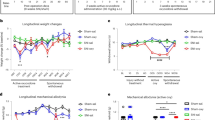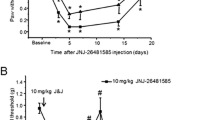Abstract
The present study has been designed to investigate the effect of selective inhibitors of histone deacetylase and/or N-acetyl-Asp-Glu-Val-Asp-al (Ac-DEVD-CHO), a selective interleukin-1β converting enzyme inhibitor, on the development of naloxone-induced opioid withdrawal syndrome both in vitro and in vivo and the effect of histone deacetylase inhibition on histone H3 acetylation in brain. Sub-acute morphine administration followed by a single injection of naloxone (8 mg/kg, i.p.) was used to precipitate opioid withdrawal syndrome in mice. Behavioral observations were made immediately after naloxone treatment. Withdrawal syndrome was quantitatively assessed in terms of withdrawal severity score and frequency of jumping, rearing, fore paw licking and circling. Separately naloxone-induced contraction in morphine-dependent isolated rat ileum was employed as an in vitro model. An isobolographic study design was employed to assess potential synergistic activity between trichostatin A and Ac-DEVD-CHO. Brain histone acetylation status was examined by western blotting. Injection of naloxone precipitated a severe form of abstinence syndrome in morphine-dependent mice along with strong contracture in isolated rat ileum. Administration of tributyrin (1.5, 3 and 6 g/kg, p.o.), trichostatin A (0.3, 1.0 and 3.0 mg/kg, p.o.) and Ac-DEVD-CHO (0.3, 1.0 and 3.0 mg/kg, p.o.) markedly and dose dependently attenuated naloxone-induced morphine withdrawal syndrome in vivo as well as in vitro in rat ileum. Trichostatin A was also observed to exert a synergistic interaction with Ac-DEVD-CHO. Western blot analysis revealed that multiple administration with the effective dose of tributyrin or trichostatin A in the in vivo experiments induced hyperacetylation of histone H3 in the mouse brain. Thus, it is proposed that histone deacetylase activation linked mechanism might be involved in the development of opioid dependence and the precipitation of its withdrawal syndrome.




Similar content being viewed by others
References
Akil H, Lewis JW (1987) Neurotransmitters and pain control. Volume 9: pain and headache. Karger, Basil, pp 129–159
Capasso A, Gallo A (2009) Molecules acting on CB1 receptor and their effects on morphine withdrawal in vitro. Open Biochem J 3:78–84
Capasso A, Sorrentino L (1997) Differential influence of D1 and D2 dopamine receptors on acute opiate withdrawal in guinea-pig isolated ileum. Br J Pharmacol 120:1001–1006
Chen ZX, Breitman TR (1994) Tributyrin: a prodrug of butyric acid for potential clinical application in differentiation therapy. Cancer Res 54(13):3494–3499
D'Amour FE, Smith DL (1941) A method for determining loss of pain sensation. J Pharmacol Exp Ther 72:74
Dokmanovic M, Clarke C, Marks PA (2007) Histone deacetylase inhibitors: overview and perspectives. Mol Canc Res 5(10):981–989
Edwards S, Graham DL, Whisler KN, Self DW (2009) Phosphorylation of GluR1, ERK, and CREB during spontaneous withdrawal from chronic heroin self-administration. Synapse 63(3):224–235
Falls WA, Kelsey JE (1989) Procedures that produce context-specific tolerance to morphine in rats also produce context-specific withdrawal. Behav Neurosci 103:842–849
Georgescu D, Zachariou V, Barrot M, Mieda M, Willie JT, Eisch AJ, Yanagisawa M, Nestler EJ, DiLeone RJ (2003) Involvement of the lateral hypothalamic peptide orexin in morphine dependence and withdrawal. J Neurosci 23:3106–3111
Glick SD, Morihisa JM (1976) Changes in sensitivity of morphine-induced circling behaviour after chronic treatment and persistence after withdrawal in rats. Nature 260:159–161
Hardman JG, Limbird LE, Gilman AG (2001) Goodman and Gilman’s the pharmacological basis of therapeutics. McGraw Hill, New York, pp 631–634
Harms KL, Chen X (2007) Histone deacetylase 2 modulates p53 transcriptional activities through regulation of p53-DNA binding activity. Cancer Res 67:3145–3152
Hu X, Bi J, Loh HH, Wei LN (2001) An intronic Ikaros-binding element mediates retinoic acid suppression of the kappa opioid receptor gene, accompanied by histone deacetylation on the promoters. J Biol Chem 276(7):4597–4603
Hwang CK, Song KY, Kim CS, Choi HS, Guo XH, Law PY, Wei LN, Loh HH (2007) Evidence of endogenous mu opioid receptor regulation by epigenetic control of the promoters. Mol Cell Biol 27(13):4720–4736
Inoue M, Mishina M, Ueda H (2003) Locus specific rescue of GluR-1 NMDA receptors in mutant mice identifies the brain regions important for morphine tolerance and dependence. J Neurosci 23:6529–6536
Jing L, Luo J, Zhang M, Qin WJ, Li YL, Liu Q, Wang YT, Lawrence AJ, Liang JH (2011) Effect of the histone deacetylase inhibitors on behavioural sensitization to a single morphine exposure in mice. Neurosci Lett 494(2):169–173
Kim SH, Jeong JW, Park JA, Lee JW, Seo JH, Jung BK, Bae MK, Kim KW (2007) Regulation of the HIF-1alpha stability by histone deacetylases. Oncol Rep 17(3):647–651
Koob GF, Bloom FE (1988) Cellular and molecular mechanisms of drug dependence. Science 242:715–723
Koodie L, Ramakrishnan S, Roy S (2010) Morphine suppresses tumor angiogenesis through a HIF-1alpha/p38MAPK pathway. Am J Pathol 177(2):984–997
Krantz MJ, Mehler PS (2004) Treating opioid dependence growing implications for primary care. Arch Intern Med 164:277–288
Law PY, Hom DS, Loh HH (1982) Loss of opiate receptor activity in neuroblastoma X glioma NG108-15 hybrid cells after chronic opiate treatment. A multiple-step process. Mol Pharmacol 22:1–4
Law PY, Wong YH, Loh HH (2000) Molecular mechanisms and regulation of opioid receptor signaling. Annu Rev Pharmacol Toxicol 40:389–430
Lee S, Rosenberg CR, Musacchio M (1987) Cross-dependence to opioid and a2-adrenergic receptor agonists in NG1O8-15 cells. FASEB J 2:52–55
Li T, Hou Y, Cao W, Yan CX, Chen T, Li SB (2010) Naloxone-precipitated withdrawal enhances ERK phosphorylation in prefrontal association cortex and accumbens nucleus of morphine-dependent mice. Neurosci Lett 468(3):348–352
Liu JG, Anand KJ (2001) Protein kinases modulate the cellular adaptations associated with opioid tolerance and dependence. Brain Res Brain Res Rev 38:1e19
Liu Z, Zheng JF, Yang LQ, Yi L, Hu B (2007) Effects of sinomenine on NO/nNOS system in cerebellum and spinal cord of morphine-dependent and withdrawal mice. Sheng Li Xue Bao 59:285–292
Liu L, Coller JK, Watkins LR, Somogyi AA, Hutchinson MR (2011) Naloxone-precipitated morphine withdrawal behavior and brain IL-1b expression: comparison of different mouse strains. Brain Behav Immun 25:1223–1232
Margonin N (1997) Substrate and inhibitor specificity of interleukin-1β converting enzyme and related caspases. J Biol Chem 272:7223
Marshall J, Graham-Smith DG (1971) Evidence against a role of brain 5-hydroxytryptamine in the development of physical dependence upon morphine in ice. J Pharmacol Exp Therapeut 173:634–641
Mundey MK, Mason R, Wilson VG (1998) Selective potentiation by ouabain of naloxone-induced withdrawal contractions of isolated guinea-pig ileum following acute exposure to morphine. Br J Pharmacol 124:911–916
Nestler EJ (2004) Historical review: molecular and cellular mechanisms of opiate and cocaine addiction. Trends Pharmacological Sci 25:210–218
Parsons CG, Gruner R, Rozental J, Millar J, Lodge D (1993) Patch clamp studies on the kinetics and selectivity of N-methyl-d-aspartate receptor antagonism by memantine (1-amino-3,5-dimethyladamantan). Neuropharmacology 32(12):1337–1350
Patkina NA, Zvartau EE (1978) Rat behavior in an “open field” when chronically administered morphine. Farmakol Toksikol 41:537–541
Pineyro G, Archer-Lahlou E (2007) Ligand-specific receptor states: implications for opiate receptor signalling and regulation. Cell Signal 19:8–19
Reagan-Shaw S, Nihal M, Ahmad N (2007) Dose translation from animal to human studies revisited. FASEB J 22:659–661
Reddy DS, Kulkarni SK (1998) Possible role of nitric oxide in the nootropic and antiamnesic effects of neurosteroids on aging and dizocilpine-induced learning impairment. Brain Res 799:215–229
Rehni AK, Singh N (2011a) Modulation of src-kinase attenuates naloxone-precipitated opioid withdrawal syndrome in mice. Behav Pharmacol 22(2):182–190
Rehni AK, Singh N (2011b) Ammonium pyrrolidine dithiocarbamate and RS 102895 attenuates opioid withdrawal in vivo and in vitro. Psychopharmacology, In press
Rehni AK, Bhateja P, Singh TG, Singh N (2008a) Nuclear factor-kappa-B inhibitor modulates the development of opioid dependence in a mouse model of naloxone-induced opioid withdrawal syndrome. Behav Pharmacol 19(3):265–269
Rehni AK, Singh I, Singh N, Bansal N, Bansal S, Kumar M (2008b) Pharmacological modulation of leukotriene D(4) attenuates the development of opioid dependence in a mouse model of naloxone-induced opioid withdrawal syndrome. Eur J Pharmacol 598(1–3):51–56
Rocchi P, Tonelli R, Camerin C, Purgato S, Fronza R, Bianucci F, Guerra F, Pession A, Ferreri AM (2005) p21Waf1/Cip1 is a common target induced by short-chain fatty acid HDAC inhibitors (valproic acid, tributyrin and sodium butyrate) in neuroblastoma cells. Oncology Rep 13(6):1139–1144
Sanchis-Segura C, Lopez-Atalaya JP, Barco A (2009) Selective boosting of transcriptional and behavioral responses to drugs of abuse by histone deacetylase inhibition. Neuropsychopharmacology 34(13):2642–2654
Sharma KS, Klee WA, Nirenberg M (1977) Opiate-dependent modulation of adenylate cyclase. Proc Natl Acad Sci U S A 74:3365–3369
Shaw-Lutchman TZ, Barrot M, Wallace T, Gilden L, Zachariou V, Impey S, Duman RS, Storm D, Nestler EJ (2002) Regional and cellular mapping of cAMP response element-mediated transcription during naltrexone precipitated morphine withdrawal. J Neurosci 22:3663–3672
Shen HY, Kalda A, Yu L, Ferrara J, Zhu J, Chen JF (2008) Additive effects of histone deacetylase inhibitors and amphetamine on histone H4 acetylation, cAMP responsive element binding protein phosphorylation and DeltaFosB expression in the striatum and locomotor sensitization in mice. Neurosci 157(3):644–655
Suzuki M, Shinohara F, Sato K, Taniguchi T, Takada H, Rikiishi H (2003) Interleukin-1β converting enzyme subfamily inhibitors prevent induction of CD86 molecules by butyrate through a CREB-dependent mechanism in HL60 cells. Immunology 108:375–383
Tallarida RJ, Porreca F, Cowan A (1989) Statistical analysis of drug–drug and site–site interactions with isobolograms. Life Sci 45:947–961
Tikoo K, Gupta S, Hamid QA, Shah V, Chatterjee B, Ali Z (1997) Structure of active chromatin: isolation and characterization of transcriptionally active chromatin from rat liver. Biochem J 322(Part 1):273–279
Tikoo K, Bhatt DK, Gaikwad AB, Sharma V, Kabra DG (2007a) Differential effects of tannic acid on cisplatin induced nephrotoxicity in rats. FEBS Lett 581:2027–2035
Tikoo K, Tripathi DN, Kabra DG, Sharma V, Gaikwad AB (2007b) Intermittent fasting prevents the progression of type I diabetic nephropathy in rats and changes the expression of Sir2 and p53. FEBS Lett 581:1071–1078
Tikoo K, Meena RL, Kabra DG, Gaikwad AB (2008) Change in post-translational modifications of histone H3, heat-shock protein-27 and MAP kinase p38 expression by curcumin in streptozotocin-induced type I diabetic nephropathy. Br J Pharmacol 153(6):1225–1231
Valeri P, Morrone LA, Romanelli L, Amico MC (1995) Acute withdrawal after bremazocine and the interaction between p- and ic-opioid receptors in isolated gut tissues. Br J Pharmacol 114:1206–1210
Van Ree JM, Gerrits MAFM, Vanderschuren LJMJ (1999) Opioids, reward and addiction: an encounter of biology, psychology, and medicine. Pharmacol Rev 51:341–396
Wang R, Zhang Y, Qing H, Liu M, Yang P (2010) The extinction of morphine-induced conditioned place preference by histone deacetylase inhibition. Neurosci Lett 483(2):137–142
Way EL, Loh HH, Shen FH (1969) Simultaneous quantitative assessment of morphine tolerance and physical dependence. J Pharmacol Exp Therapeut 167:1–8
Williams JT, Christie MJ, Manzoni O (2001) Cellular and synaptic adaptations mediating opioid dependence. Physiol Rev 81:299–343
World Health Organisation (2003) Management of substance dependence, http://www.who.int/substance_abuse; 01/03
Yoshida M, Horinouchi S, Beppu T (1995) Trichostatin and trapoxin: novel chemical probes for the role of histone acetylation in chromatin structure and function. Bioassays 17(5):423–430
Acknowledgements
The authors are thankful to Mr. Amteshwar Singh Jaggi, Assistant Professor, Department of Pharmaceutical Sciences and Drug Research, Punjabi University, Patiala, India, for his valuable suggestions. The authors are grateful to Madhu Chitkara, General Secretary, Chitkara Educational Trust, Chandigarh, and Dr. Sandeep Arora, Director, Chitkara College of Pharmacy, Rajpura, Patiala, India, for the institutional facilities. This research was financially supported by the Department of Pharmaceutical Sciences and Drug Research, Punjabi University, Patiala, India.
Conflict of interest
All authors declare that they have no conflict of interest.
Author information
Authors and Affiliations
Corresponding author
Rights and permissions
About this article
Cite this article
Rehni, A.K., Singh, N., Rachamalla, M. et al. Modulation of histone deacetylase attenuates naloxone-precipitated opioid withdrawal syndrome. Naunyn-Schmiedeberg's Arch Pharmacol 385, 605–619 (2012). https://doi.org/10.1007/s00210-012-0739-x
Received:
Accepted:
Published:
Issue Date:
DOI: https://doi.org/10.1007/s00210-012-0739-x




